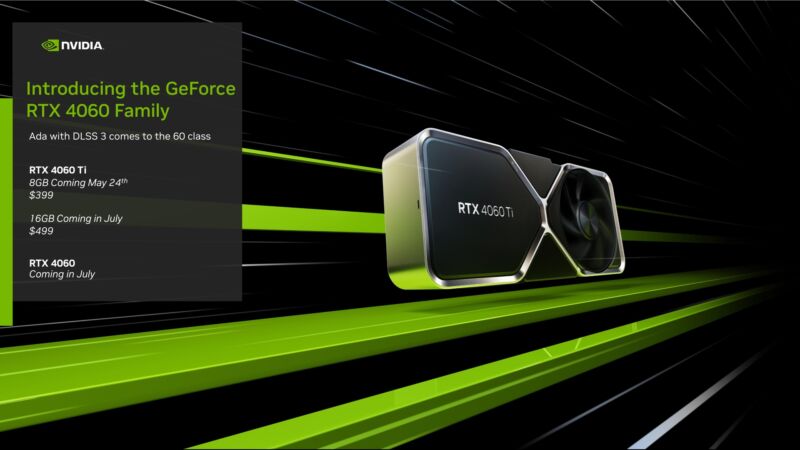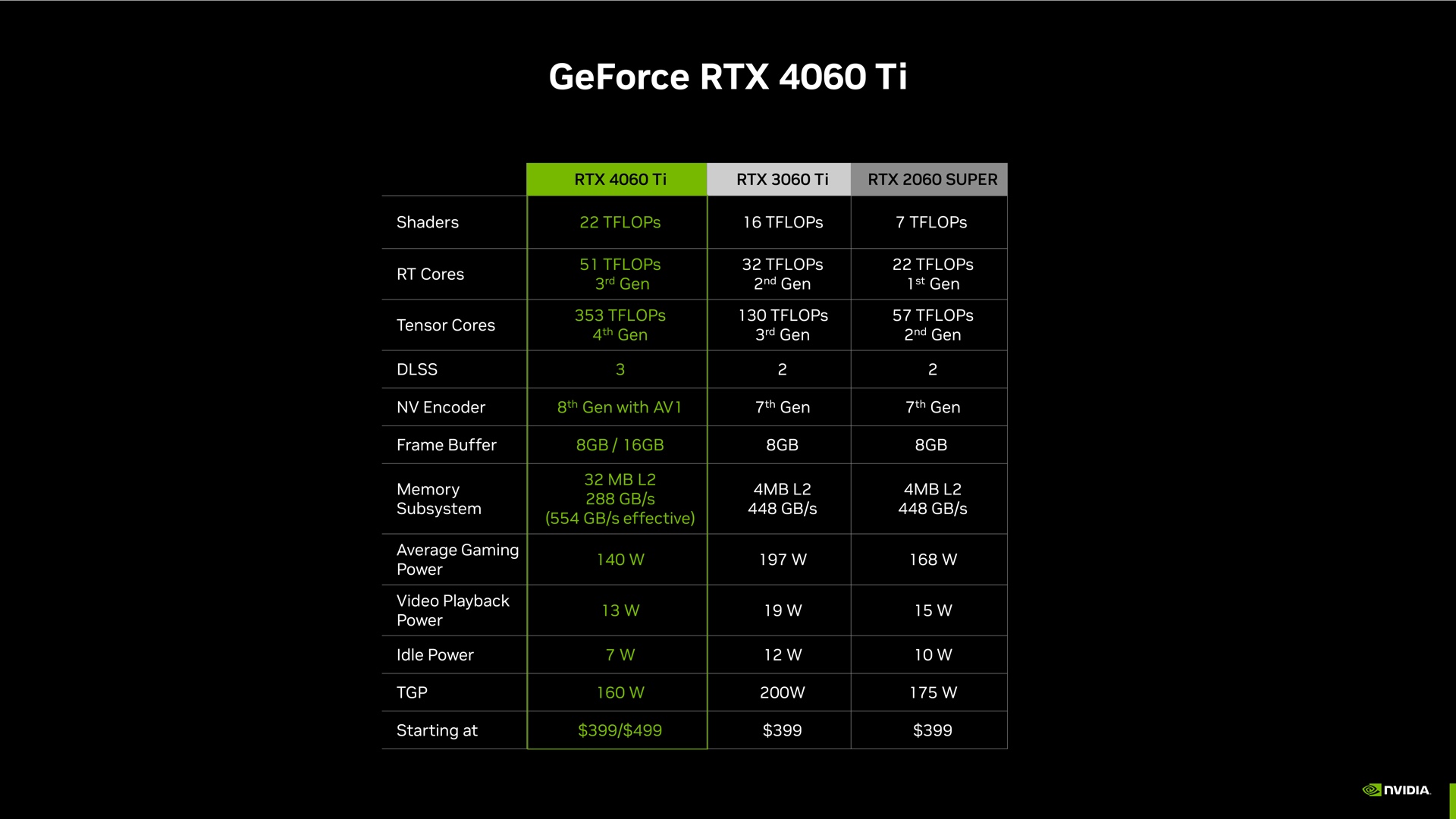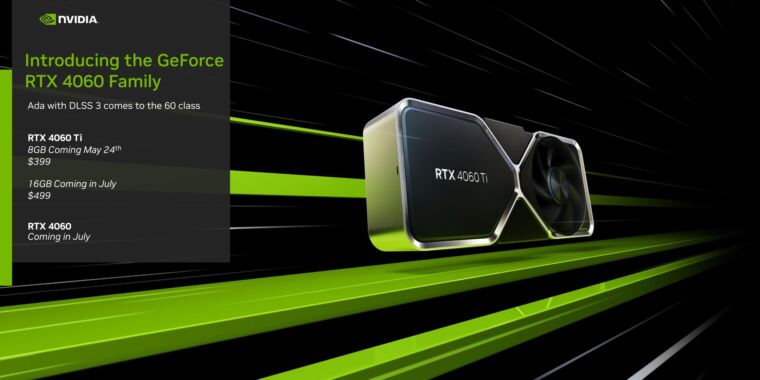
Nvidia
Nvidia is beginning to roll out its new Ada Lovelace GPU architecture to sub-$500 graphics cards, the models that the vast majority of PC gamers buy and use. There’s good news and bad news.
The good news is that the GeForce RTX 4060 Ti will launch on May 24 for $399, the same price that the RTX 3060 Ti launched for in December 2020—it’s the first GPU launch in ages not to come with a price hike built in. Like other RTX 4000-series GPUs, it supports DLSS 3’s AI-assisted frame rate-boosting technologies and AV1 video encoding support, and it’s much more power-efficient than its predecessors. The bad news is that the 4060 Ti is an unusually mild upgrade over the 3060 Ti, with the same 8GB bank of RAM and (according to Nvidia) just 15 percent faster performance than the 3060 Ti in games without the DLSS Frame Generation feature enabled.
-
When DLSS FG is out of the picture, the 4060 Ti is about 15 percent faster than a 3060 Ti. Obviously comparisons against older cards will be even better, and most people choose not to upgrade their GPU every single generation.
Nvidia -
The DLSS FG games, accordingly, show a larger improvement than the games that don’t support it.
Nvidia -
The 16GB version of the 4060 Ti helps in just a couple of the games in Nvidia’s test suite, though this may change as time goes on.
Nvidia
Nvidia will sell a Founders Edition version of the 4060 Ti that looks about the same size as its Founders Edition RTX 4070; it also uses the new 12VHPWR connector, though cards from Nvidia’s partners will often opt to use a traditional 8-pin power connector instead.
Nvidia will fill out the 4060 lineup later in July; a $499 4060 Ti with 16GB of memory will sit in between the 8GB model and the $599 RTX 4070. A lower-end non-Ti RTX 4060 will also launch for $299, a small drop from the 3060’s $329 introductory price for what Nvidia says should be 20 percent better performance; not a bad deal for the first generation-over-generation price drop we’ve seen from Nvidia in years. The 8GB 4060 Ti and 4060 are both pitched as 1080p cards, partly because 8GB of graphics memory is becoming a bottleneck in newer games at higher resolutions.
Meet AD106
| RTX 4090 | RTX 4080 | RTX 4070 Ti | RTX 4070 | RTX 4060 Ti | RTX 4060 | RTX 3060 Ti | RTX 3060 | |
|---|---|---|---|---|---|---|---|---|
| CUDA Cores | 16,384 | 9,728 | 7,680 | 5,888 | 4,352 | 3,840? | 4,864 | 3,584 |
| Boost Clock | 2,520 MHz | 2,505 MHz | 2,610 MHz | 2,475 MHz | 2,535 MHz | ? | 1,665 MHz | 1,777 MHz |
| Memory Bus Width | 384-bit | 256-bit | 192-bit | 192-bit | 128-bit | 128-bit | 256-bit | 192-bit |
| Memory Clock | 1,313 MHz | 1,400 MHz | 1,313 MHz | 1,313 MHz | 2,250 MHz | ? | 1,750 MHz | 1,875 MHz |
| Memory size | 24GB GDDR6X | 16GB GDDR6X | 12GB GDDR6X | 12GB GDDR6X | 8GB or 16GB GDDR6 | 8GB GDDR6 | 8GB GDDR6 | 12GB GDDR6 |
| TGP | 450 W | 320 W | 285 W | 200 W | 160 W | 115 W | 200 W | 170 W |
The entire 4060 series is based on the AD106 GPU die, the fourth and smallest (so far) of the chips Nvidia has shipped in the RTX 4000 series after the AD102 (4090), AD103 (4080), and AD104 (4070 series). The AD106 die is also used in the laptop versions of the RTX 4070.
A fully enabled AD106 die includes 4,608 of Nvidia’s CUDA cores on a 128-bit memory interface, but both 4060-series GPUs use a partially disabled version (see the table above for details). As rumored, the 4060 Ti’s specs are a bit underwhelming when compared directly to the 3060 Ti, which had more CUDA cores and a 256-bit bus, which contributes to its smaller-than-typical improvement over the last-gen card. The other RTX 4000-series GPUs have typically included as many or more CUDA cores than their RTX 3000-series counterparts, though narrower memory bus widths have been the norm for every GPU other than the 4090.
-
A fully enabled AD106 die.
Nvidia -
The 4060’s version of AD106 is nearly fully enabled, but some of the CUDA cores have been shut off.
-
The regular RTX 4060, predictably, has fewer execution resources and less L2 cache than the 4060 Ti across the board.
Nvidia
To close that gap, the 4060 Ti benefits from Ada’s architectural improvements, plus significantly higher clock speeds. Nvidia has also added extra L2 cache to save on the number of times the GPU needs to go out to main memory, reducing the impact of the narrower memory bus (the 4060 Ti has 32MB of L2 cache, and the 4060 has 24MB, compared to 4MB and 3MB for the 3060 Ti and 3060).
Nvidia’s press briefing and slide deck avoided comparing most of these specs directly, opting instead to do generation-over-generation spec comparisons using TFLOP numbers. Clearly, the intent is to drive home that the 4060 Ti is a faster card than the 3060 Ti despite these specs, because people who follow GPU news online are incapable of being chill when they perceive that a product has been named wrong or positioned wrong or priced wrong (expect a fair amount of outrage about this to be expressed via YouTube thumbnails).

Nvidia’s press briefing used TFLOP numbers instead of the number of cores or memory bus width here, since the numbers don’t look very flattering out of context.
Nvidia
One of the things that impressed us most about the RTX 4070 was its power efficiency, and both RTX 4060 GPUs look pretty good on that front, too. The 4060 Ti comes with a TGP of 160 W, compared to 200 W for the 3060 Ti, while the 4060 only needs 115 W instead of 170 W. That’s awfully close to the 75 W of power that a PCI Express slot can provide without an external power connector—a hypothetical RTX 4050 could hit that number, which could bode well for people trying to put a GPU into an underpowered budget desktop tower from Dell or HP with no 8-pin power connectors to spare.
